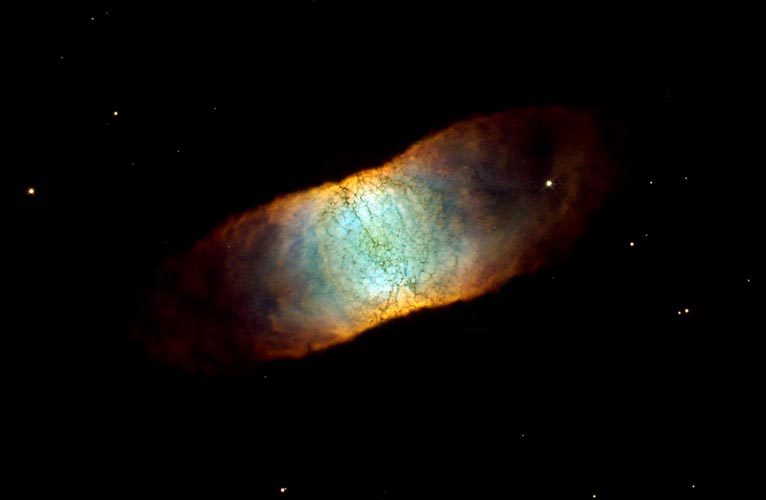
Description: Bipolar Planetary Nebula
Position (J2000): R.A. 14h 22m 25.9s Dec. -44° 09' 00"
Constellation: Lupus
Distance: About 600 parsecs (1900 light-years)
Dimensions: The diameter across the short dimension of the nebula is 0.08 parsecs (0.25 light-years) while the long dimension is 3.6 times as large.
Instrument: WFPC2
Exposure Date(s): June 28, 2001; January 19, 2002
Exposure Time: 1.3 hours
Image Credit: NASA and The Hubble Heritage Team (STScI/AURA)
Release Date: June 13, 2002
2017 Image
ABOUT THIS IMAGE:
This Hubble image shows a dying star, IC 4406, dubbed the "Retina Nebula".
Like many other so-called planetary nebulae, IC 4406 exhibits a high degree of symmetry; the left and right halves of the Hubble image are nearly mirror images of the other. If we could fly around IC 4406 in a starship, we would see that the gas and dust form a vast donut of material streaming outward from the dying star. From Earth, we are viewing the donut from the side. This side view allows us to see the intricate tendrils of dust that have been compared to the eye's retina. In fact, IC 4406 is dubbed the "Retina Nebula." In other planetary nebulae, like the Ring Nebula (NGC 6720), we view the donut from the top.
The donut of material confines the intense radiation coming from the remnant of the dying star. Gas on the inside of the donut is ionized by light from the central star and glows. Light from oxygen atoms is rendered blue in this image; hydrogen is shown as green, and nitrogen as red. The range of color in the final image shows the differences in concentration of these three gases in the nebula.
Unseen in the Hubble image is a larger zone of neutral gas that is not emitting visible light, but which can be seen by radio telescopes.
One of the most interesting features of IC 4406 is the irregular lattice of dark lanes that criss-cross the center of the nebula. These lanes are about 160 astronomical units wide (1 astronomical unit is the distance between the Earth and Sun). They are located right at the boundary between the hot glowing gas that produces the visual light imaged here and the neutral gas seen with radio telescopes. We see the lanes in silhouette because they have a density of dust and gas that is a thousand times higher than the rest of the nebula. The dust lanes are like a rather open mesh veil that has been wrapped around the bright donut.
The
fate of these dense knots of material is unknown. Will they survive the
nebula's expansion and become dark denizens of the space between the stars
or simply dissipate?
Q & A: Understanding the Discovery
1. What caused the dark tendrils of material in the center of the nebula?
The dark tendrils are dust lanes that were created at the boundary between the hot, colorful, glowing gas and cooler, "neutral" gas. The neutral gas does not glow and therefore cannot be seen in visible light. But this cool gas does comprise the dark dust lanes. The gas can be seen in silhouette because it is so dense. In fact, the gas in the dust lanes is 1,000 times denser than the gas in the rest of the nebula.
The
lanes were formed because the boundary between the gases is unstable.
This instability creates irregularities on the nebula's surface, causing
the neutral gas to clump together in certain areas, much like puddles
forming on a prairie after a rain. These puddles of material eventually
became dense enough to be seen in silhouette. The dust lanes are like
a mesh veil that has been wrapped around the bright donut.
2. Have ground-based telescopes imaged this dying star?
Yes.
The object has an IC (Index Catalog) number, indicating that it was first
seen and recorded in the 19th century. The Hubble telescope has allowed
astronomers to see IC 4406 in greater detail and to determine its three-dimensional
structure.